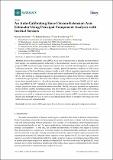| dc.contributor.author | McGrath, Timothy Michael | |
| dc.contributor.author | Fineman, Richard Andres | |
| dc.contributor.author | Stirling, Leia A. | |
| dc.date.accessioned | 2018-06-26T15:06:15Z | |
| dc.date.available | 2018-06-26T15:06:15Z | |
| dc.date.issued | 2018-06 | |
| dc.identifier.issn | 1424-8220 | |
| dc.identifier.uri | http://hdl.handle.net/1721.1/116622 | |
| dc.description.abstract | Inertial measurement units (IMUs) have been demonstrated to reliably measure human joint angles—an essential quantity in the study of biomechanics. However, most previous literature proposed IMU-based joint angle measurement systems that required manual alignment or prescribed calibration motions. This paper presents a simple, physically-intuitive method for IMU-based measurement of the knee flexion/extension angle in gait without requiring alignment or discrete calibration, based on computationally-efficient and easy-to-implement Principle Component Analysis (PCA). The method is compared against an optical motion capture knee flexion/extension angle modeled through OpenSim. The method is evaluated using both measured and simulated IMU data in an observational study (<i>n</i> = 15) with an absolute root-mean-square-error (RMSE) of 9.24<inline-formula><math display="inline"><semantics><msup><mrow></mrow><mo>∘</mo></msup></semantics></math></inline-formula> and a zero-mean RMSE of 3.49<inline-formula><math display="inline"><semantics><msup><mrow></mrow><mo>∘</mo></msup></semantics></math></inline-formula>. Variation in error across subjects was found, made emergent by the larger subject population than previous literature considers. Finally, the paper presents an explanatory model of RMSE on IMU mounting location. The observational data suggest that RMSE of the method is a function of thigh IMU perturbation and axis estimation quality. However, the effect size for these parameters is small in comparison to potential gains from improved IMU orientation estimations. Results also highlight the need to set relevant datums from which to interpret joint angles for both truth references and estimated data. | en_US |
| dc.description.sponsorship | National Science Foundation (U.S.) (GRFP) | en_US |
| dc.description.sponsorship | National Science Foundation (U.S.) (IIS-1453141) | en_US |
| dc.publisher | Multidisciplinary Digital Publishing Institute | en_US |
| dc.relation.isversionof | http://dx.doi.org/10.3390/s18061882 | en_US |
| dc.rights | Creative Commons Attribution | en_US |
| dc.rights.uri | http://creativecommons.org/licenses/by/4.0/ | en_US |
| dc.source | Multidisciplinary Digital Publishing Institute | en_US |
| dc.title | An Auto-Calibrating Knee Flexion-Extension Axis Estimator Using Principal Component Analysis with Inertial Sensors | en_US |
| dc.type | Article | en_US |
| dc.identifier.citation | McGrath, Timothy, Richard Fineman and Leia Stirling. "An Auto-Calibrating Knee Flexion-Extension Axis Estimator Using Principal Component Analysis with Inertial Sensors." Sensors 2018, 18(6), 1882. | en_US |
| dc.contributor.department | Institute for Medical Engineering and Science | en_US |
| dc.contributor.department | Massachusetts Institute of Technology. Department of Aeronautics and Astronautics | en_US |
| dc.contributor.mitauthor | McGrath, Timothy Michael | |
| dc.contributor.mitauthor | Fineman, Richard Andres | |
| dc.contributor.mitauthor | Stirling, Leia A. | |
| dc.relation.journal | Sensors | en_US |
| dc.eprint.version | Final published version | en_US |
| dc.type.uri | http://purl.org/eprint/type/JournalArticle | en_US |
| eprint.status | http://purl.org/eprint/status/PeerReviewed | en_US |
| dc.date.updated | 2018-06-25T07:43:21Z | |
| dspace.orderedauthors | McGrath, Timothy; Fineman, Richard; Stirling, Leia | en_US |
| dspace.embargo.terms | N | en_US |
| dc.identifier.orcid | https://orcid.org/0000-0002-6582-0865 | |
| dc.identifier.orcid | https://orcid.org/0000-0003-1672-8189 | |
| dc.identifier.orcid | https://orcid.org/0000-0002-0119-1617 | |
| mit.license | PUBLISHER_CC | en_US |
